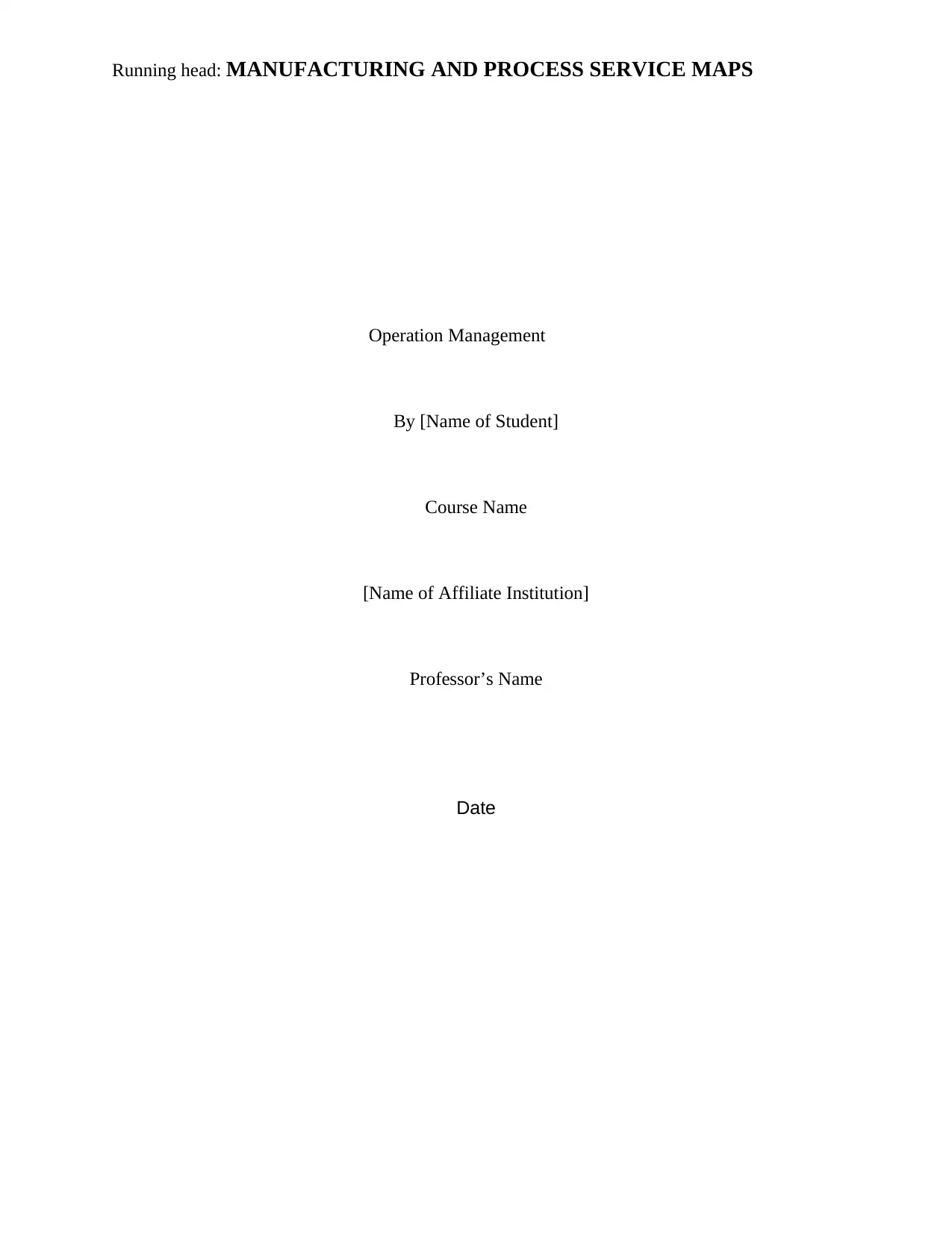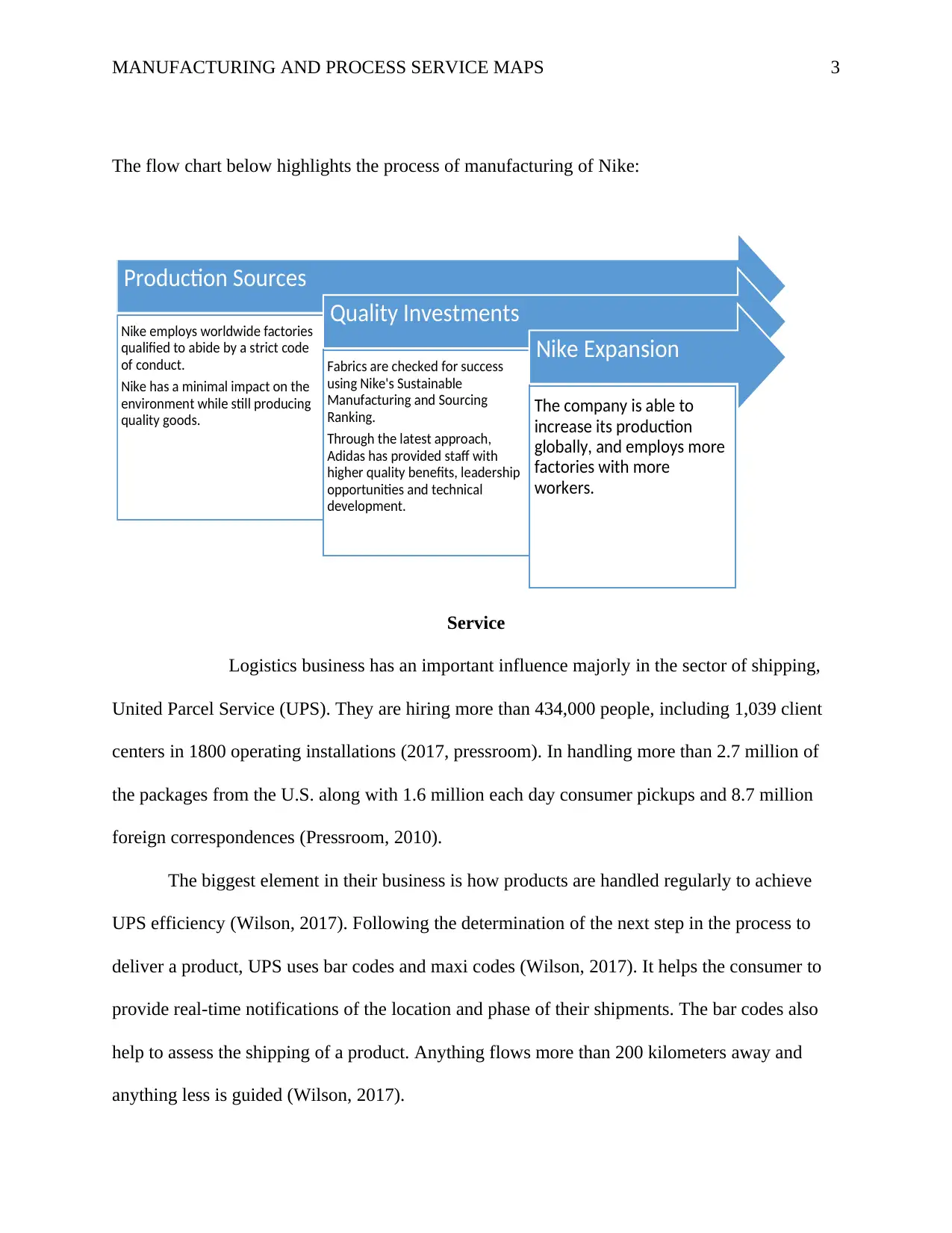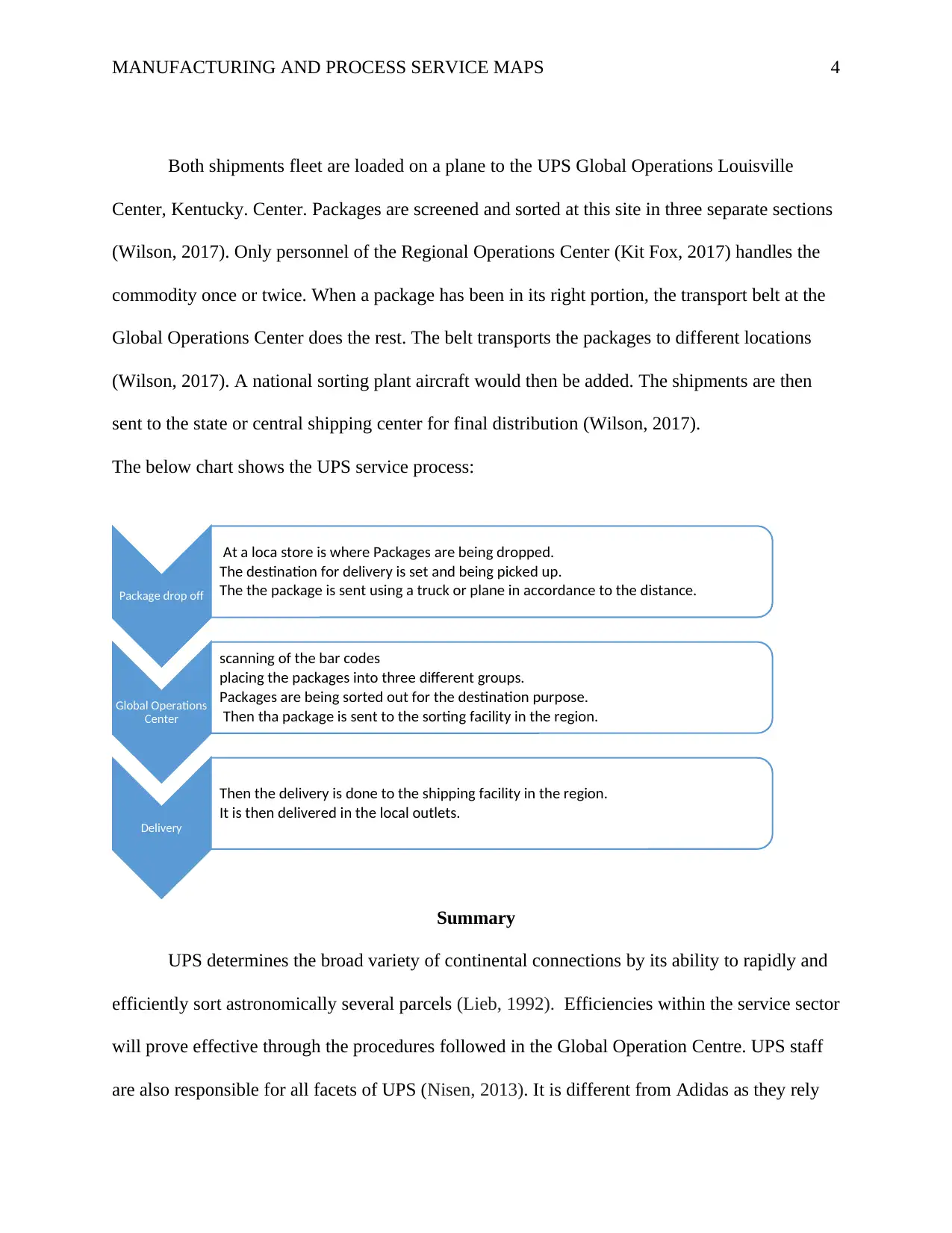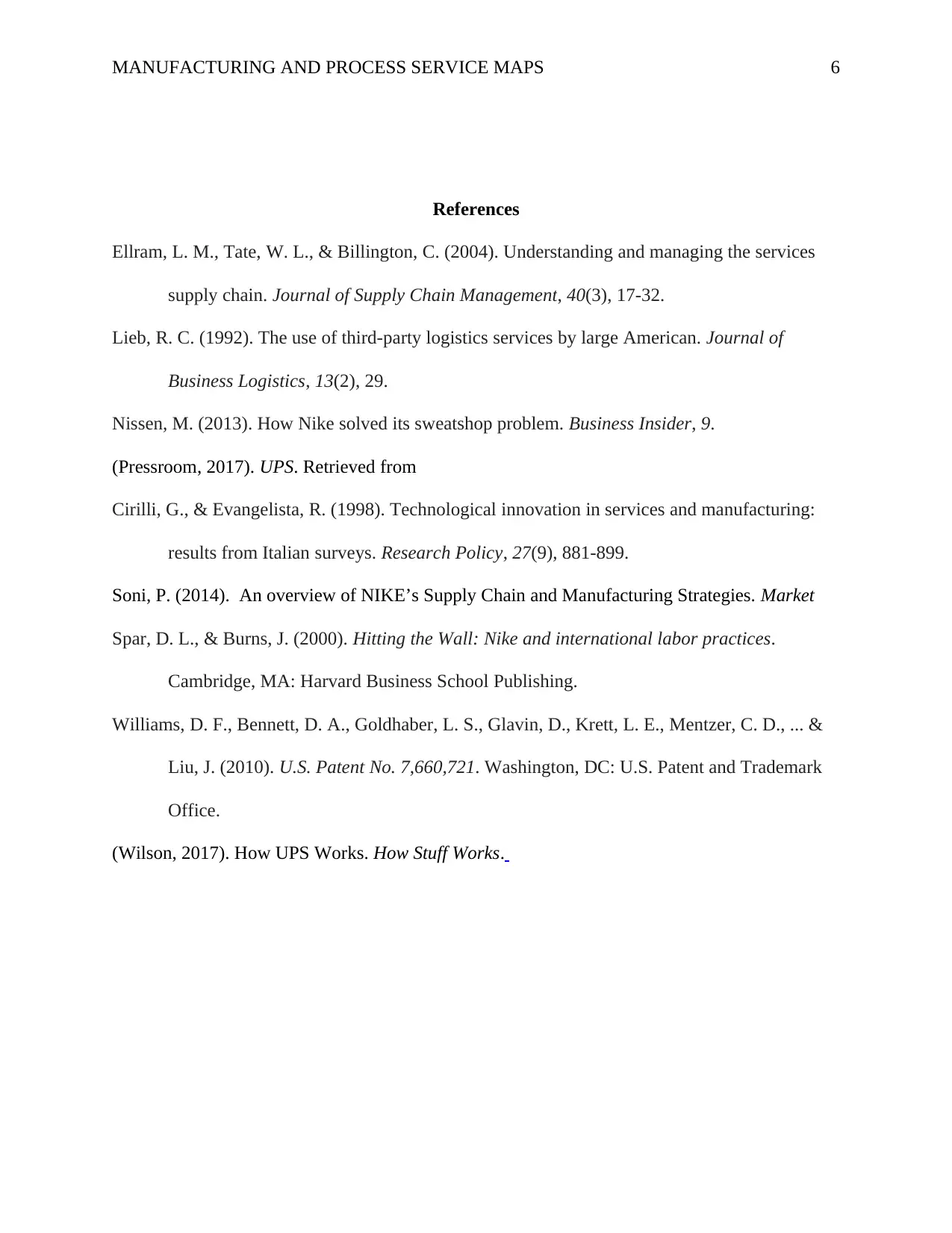Manufacturing and Service Process Maps: Company Analysis Report
VerifiedAdded on 2022/09/24
|6
|1048
|26
Report
AI Summary
This report provides a comparative analysis of manufacturing and service process maps, focusing on Nike and UPS respectively. The report begins by establishing the core operations of each company, highlighting Nike's extensive global manufacturing network and UPS's complex logistics infrastructure. It then delves into the creation of process maps for both companies, illustrating the flow of production and service delivery. The Nike section details its manufacturing process, emphasizing its reliance on third-party manufacturers and its supply chain management. The UPS section examines the service process, from package handling to global distribution, highlighting the importance of technology and efficiency. The report concludes by summarizing the key differences and similarities between the two companies, emphasizing the importance of efficient operations and supply chain management in both manufacturing and service-oriented businesses. References supporting the process maps are also included.

Running head: MANUFACTURING AND PROCESS SERVICE MAPS
Operation Management
By [Name of Student]
Course Name
[Name of Affiliate Institution]
Professor’s Name
Date
Operation Management
By [Name of Student]
Course Name
[Name of Affiliate Institution]
Professor’s Name
Date
Paraphrase This Document
Need a fresh take? Get an instant paraphrase of this document with our AI Paraphraser

MANUFACTURING AND PROCESS SERVICE MAPS
Manufacturing and Service Process Maps
To be able to thrive, every business needs to understand the whole operation of the
corporations and the difference in return making despite being offering services or supplies. The
operating aspect similarly relates to the reliability of their supply chain, allowing both their
customers and their suppliers to have faith in the continuous delivery of a superiority product or
provision. Both manufacturing and service-oriented company are shown in these studies and how
they are being differentiated and the contrast in each product of the process map.
Manufacturing
Currently, Nike has more than 591 sites of manufacturing in more than 42 (Nike, 2017).
Nike's conviction is that manufacturing changes will further reinvent the nature of the supply
chain not only benefit the business but also its citizens. Nike also uses a sustainable
manufacturing and procurement system to assess whether a factory implements procedures and
delivers on manufacturing output levels (Transform Manufacturing, 2017). Respectively the
conduct of the stringent code of each factory which allows the collaboration of Nike in full
control of all plants in the operation of a fair supply in chain management (Code of Conduct,
2017).
For a company with Nike's size, one thing is that they do not have any clothing and
clothes factory that accounts for 88% with their sales (Soni, 2014). Nike then pays third-party
companies to manufacture so they can keep their costs down (Soni, 2014).
Nike reflects also on how the distribution network communicates to one another. All facets of its
supply chain must be on one page with more than 700 companies and merchandise flowing from
57 distribution centers across an 18,500-account network into over 140,000 retailers (Soni,
2014).
2
Manufacturing and Service Process Maps
To be able to thrive, every business needs to understand the whole operation of the
corporations and the difference in return making despite being offering services or supplies. The
operating aspect similarly relates to the reliability of their supply chain, allowing both their
customers and their suppliers to have faith in the continuous delivery of a superiority product or
provision. Both manufacturing and service-oriented company are shown in these studies and how
they are being differentiated and the contrast in each product of the process map.
Manufacturing
Currently, Nike has more than 591 sites of manufacturing in more than 42 (Nike, 2017).
Nike's conviction is that manufacturing changes will further reinvent the nature of the supply
chain not only benefit the business but also its citizens. Nike also uses a sustainable
manufacturing and procurement system to assess whether a factory implements procedures and
delivers on manufacturing output levels (Transform Manufacturing, 2017). Respectively the
conduct of the stringent code of each factory which allows the collaboration of Nike in full
control of all plants in the operation of a fair supply in chain management (Code of Conduct,
2017).
For a company with Nike's size, one thing is that they do not have any clothing and
clothes factory that accounts for 88% with their sales (Soni, 2014). Nike then pays third-party
companies to manufacture so they can keep their costs down (Soni, 2014).
Nike reflects also on how the distribution network communicates to one another. All facets of its
supply chain must be on one page with more than 700 companies and merchandise flowing from
57 distribution centers across an 18,500-account network into over 140,000 retailers (Soni,
2014).
2

MANUFACTURING AND PROCESS SERVICE MAPS
The flow chart below highlights the process of manufacturing of Nike:
Service
Logistics business has an important influence majorly in the sector of shipping,
United Parcel Service (UPS). They are hiring more than 434,000 people, including 1,039 client
centers in 1800 operating installations (2017, pressroom). In handling more than 2.7 million of
the packages from the U.S. along with 1.6 million each day consumer pickups and 8.7 million
foreign correspondences (Pressroom, 2010).
The biggest element in their business is how products are handled regularly to achieve
UPS efficiency (Wilson, 2017). Following the determination of the next step in the process to
deliver a product, UPS uses bar codes and maxi codes (Wilson, 2017). It helps the consumer to
provide real-time notifications of the location and phase of their shipments. The bar codes also
help to assess the shipping of a product. Anything flows more than 200 kilometers away and
anything less is guided (Wilson, 2017).
Production Sources
Nike employs worldwide factories
qualified to abide by a strict code
of conduct.
Nike has a minimal impact on the
environment while still producing
quality goods.
Quality Investments
Fabrics are checked for success
using Nike's Sustainable
Manufacturing and Sourcing
Ranking.
Through the latest approach,
Adidas has provided staff with
higher quality benefits, leadership
opportunities and technical
development.
Nike Expansion
The company is able to
increase its production
globally, and employs more
factories with more
workers.
3
The flow chart below highlights the process of manufacturing of Nike:
Service
Logistics business has an important influence majorly in the sector of shipping,
United Parcel Service (UPS). They are hiring more than 434,000 people, including 1,039 client
centers in 1800 operating installations (2017, pressroom). In handling more than 2.7 million of
the packages from the U.S. along with 1.6 million each day consumer pickups and 8.7 million
foreign correspondences (Pressroom, 2010).
The biggest element in their business is how products are handled regularly to achieve
UPS efficiency (Wilson, 2017). Following the determination of the next step in the process to
deliver a product, UPS uses bar codes and maxi codes (Wilson, 2017). It helps the consumer to
provide real-time notifications of the location and phase of their shipments. The bar codes also
help to assess the shipping of a product. Anything flows more than 200 kilometers away and
anything less is guided (Wilson, 2017).
Production Sources
Nike employs worldwide factories
qualified to abide by a strict code
of conduct.
Nike has a minimal impact on the
environment while still producing
quality goods.
Quality Investments
Fabrics are checked for success
using Nike's Sustainable
Manufacturing and Sourcing
Ranking.
Through the latest approach,
Adidas has provided staff with
higher quality benefits, leadership
opportunities and technical
development.
Nike Expansion
The company is able to
increase its production
globally, and employs more
factories with more
workers.
3
⊘ This is a preview!⊘
Do you want full access?
Subscribe today to unlock all pages.

Trusted by 1+ million students worldwide

MANUFACTURING AND PROCESS SERVICE MAPS
Both shipments fleet are loaded on a plane to the UPS Global Operations Louisville
Center, Kentucky. Center. Packages are screened and sorted at this site in three separate sections
(Wilson, 2017). Only personnel of the Regional Operations Center (Kit Fox, 2017) handles the
commodity once or twice. When a package has been in its right portion, the transport belt at the
Global Operations Center does the rest. The belt transports the packages to different locations
(Wilson, 2017). A national sorting plant aircraft would then be added. The shipments are then
sent to the state or central shipping center for final distribution (Wilson, 2017).
The below chart shows the UPS service process:
Summary
UPS determines the broad variety of continental connections by its ability to rapidly and
efficiently sort astronomically several parcels (Lieb, 1992). Efficiencies within the service sector
will prove effective through the procedures followed in the Global Operation Centre. UPS staff
are also responsible for all facets of UPS (Nisen, 2013). It is different from Adidas as they rely
Package drop off
At a loca store is where Packages are being dropped.
The destination for delivery is set and being picked up.
The the package is sent using a truck or plane in accordance to the distance.
Global Operations
Center
scanning of the bar codes
placing the packages into three different groups.
Packages are being sorted out for the destination purpose.
Then tha package is sent to the sorting facility in the region.
Delivery
Then the delivery is done to the shipping facility in the region.
It is then delivered in the local outlets.
4
Both shipments fleet are loaded on a plane to the UPS Global Operations Louisville
Center, Kentucky. Center. Packages are screened and sorted at this site in three separate sections
(Wilson, 2017). Only personnel of the Regional Operations Center (Kit Fox, 2017) handles the
commodity once or twice. When a package has been in its right portion, the transport belt at the
Global Operations Center does the rest. The belt transports the packages to different locations
(Wilson, 2017). A national sorting plant aircraft would then be added. The shipments are then
sent to the state or central shipping center for final distribution (Wilson, 2017).
The below chart shows the UPS service process:
Summary
UPS determines the broad variety of continental connections by its ability to rapidly and
efficiently sort astronomically several parcels (Lieb, 1992). Efficiencies within the service sector
will prove effective through the procedures followed in the Global Operation Centre. UPS staff
are also responsible for all facets of UPS (Nisen, 2013). It is different from Adidas as they rely
Package drop off
At a loca store is where Packages are being dropped.
The destination for delivery is set and being picked up.
The the package is sent using a truck or plane in accordance to the distance.
Global Operations
Center
scanning of the bar codes
placing the packages into three different groups.
Packages are being sorted out for the destination purpose.
Then tha package is sent to the sorting facility in the region.
Delivery
Then the delivery is done to the shipping facility in the region.
It is then delivered in the local outlets.
4
Paraphrase This Document
Need a fresh take? Get an instant paraphrase of this document with our AI Paraphraser

MANUFACTURING AND PROCESS SERVICE MAPS
on third-country organizations, but need strict guidelines in leased factories. The two companies
are related as they both concentrate on ensuring that products hit the correct distribution point.
To both businesses, this is important, because consumers depend on every company to be
successful and provide their package because planned.
5
on third-country organizations, but need strict guidelines in leased factories. The two companies
are related as they both concentrate on ensuring that products hit the correct distribution point.
To both businesses, this is important, because consumers depend on every company to be
successful and provide their package because planned.
5

MANUFACTURING AND PROCESS SERVICE MAPS
References
Ellram, L. M., Tate, W. L., & Billington, C. (2004). Understanding and managing the services
supply chain. Journal of Supply Chain Management, 40(3), 17-32.
Lieb, R. C. (1992). The use of third-party logistics services by large American. Journal of
Business Logistics, 13(2), 29.
Nissen, M. (2013). How Nike solved its sweatshop problem. Business Insider, 9.
(Pressroom, 2017). UPS. Retrieved from
Cirilli, G., & Evangelista, R. (1998). Technological innovation in services and manufacturing:
results from Italian surveys. Research Policy, 27(9), 881-899.
Soni, P. (2014). An overview of NIKE’s Supply Chain and Manufacturing Strategies. Market
Spar, D. L., & Burns, J. (2000). Hitting the Wall: Nike and international labor practices.
Cambridge, MA: Harvard Business School Publishing.
Williams, D. F., Bennett, D. A., Goldhaber, L. S., Glavin, D., Krett, L. E., Mentzer, C. D., ... &
Liu, J. (2010). U.S. Patent No. 7,660,721. Washington, DC: U.S. Patent and Trademark
Office.
(Wilson, 2017). How UPS Works. How Stuff Works.
6
References
Ellram, L. M., Tate, W. L., & Billington, C. (2004). Understanding and managing the services
supply chain. Journal of Supply Chain Management, 40(3), 17-32.
Lieb, R. C. (1992). The use of third-party logistics services by large American. Journal of
Business Logistics, 13(2), 29.
Nissen, M. (2013). How Nike solved its sweatshop problem. Business Insider, 9.
(Pressroom, 2017). UPS. Retrieved from
Cirilli, G., & Evangelista, R. (1998). Technological innovation in services and manufacturing:
results from Italian surveys. Research Policy, 27(9), 881-899.
Soni, P. (2014). An overview of NIKE’s Supply Chain and Manufacturing Strategies. Market
Spar, D. L., & Burns, J. (2000). Hitting the Wall: Nike and international labor practices.
Cambridge, MA: Harvard Business School Publishing.
Williams, D. F., Bennett, D. A., Goldhaber, L. S., Glavin, D., Krett, L. E., Mentzer, C. D., ... &
Liu, J. (2010). U.S. Patent No. 7,660,721. Washington, DC: U.S. Patent and Trademark
Office.
(Wilson, 2017). How UPS Works. How Stuff Works.
6
⊘ This is a preview!⊘
Do you want full access?
Subscribe today to unlock all pages.

Trusted by 1+ million students worldwide
1 out of 6
Related Documents
Your All-in-One AI-Powered Toolkit for Academic Success.
+13062052269
info@desklib.com
Available 24*7 on WhatsApp / Email
![[object Object]](/_next/static/media/star-bottom.7253800d.svg)
Unlock your academic potential
Copyright © 2020–2025 A2Z Services. All Rights Reserved. Developed and managed by ZUCOL.





